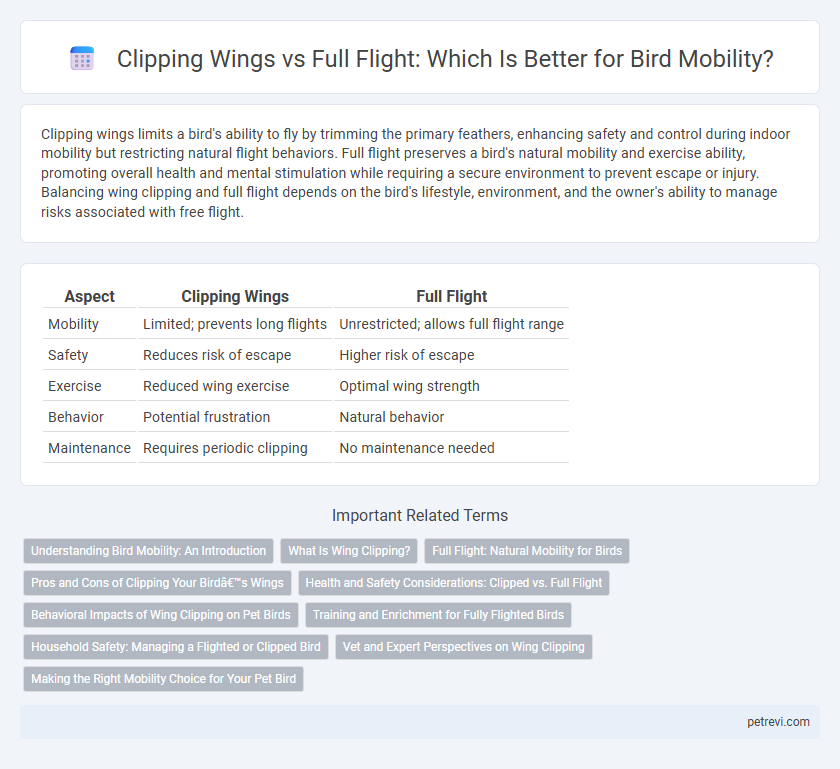Clipping wings limits a bird's ability to fly by trimming the primary feathers, enhancing safety and control during indoor mobility but restricting natural flight behaviors. Full flight preserves a bird's natural mobility and exercise ability, promoting overall health and mental stimulation while requiring a secure environment to prevent escape or injury. Balancing wing clipping and full flight depends on the bird's lifestyle, environment, and the owner's ability to manage risks associated with free flight.
Table of Comparison
| Aspect | Clipping Wings | Full Flight |
|---|---|---|
| Mobility | Limited; prevents long flights | Unrestricted; allows full flight range |
| Safety | Reduces risk of escape | Higher risk of escape |
| Exercise | Reduced wing exercise | Optimal wing strength |
| Behavior | Potential frustration | Natural behavior |
| Maintenance | Requires periodic clipping | No maintenance needed |
Understanding Bird Mobility: An Introduction
Clipping wings limits a bird's ability to achieve full lift and sustained flight, affecting natural behaviors such as foraging and migration. Full flight preserves wing integrity, allowing unrestricted movement and enabling birds to navigate varied environments for survival and social interaction. Understanding these differences is crucial for responsible bird care and conservation strategies.
What Is Wing Clipping?
Wing clipping involves trimming the primary flight feathers of a bird to limit its ability to fly, which enhances safety and control within indoor or confined environments. This procedure does not harm the bird when performed correctly and aims to reduce the risk of injury or escape. Full flight enables natural mobility and exercise, but requires more space and supervision to ensure the bird's well-being.
Full Flight: Natural Mobility for Birds
Full flight preserves a bird's natural mobility by allowing unrestricted wing movement, essential for accurate navigation, foraging, and evading predators. Maintaining full flight capability supports muscle strength, coordination, and mental well-being by enabling normal exercise and environmental interaction. Birds with full flight exhibit enhanced survival skills and overall health compared to those with clipped wings.
Pros and Cons of Clipping Your Bird’s Wings
Clipping a bird's wings restricts flight, reducing escape risks and injury but limits natural exercise and mental stimulation needed for overall health. Full flight allows birds to maintain physical fitness, explore their environment, and express natural behaviors, though it increases the chance of accidents or escape in non-secure spaces. Balancing bird safety and mobility requires careful consideration of species traits, cage environment, and owner capability.
Health and Safety Considerations: Clipped vs. Full Flight
Clipping wings restricts a bird's ability to fly, reducing risks of injury from high falls or escape but may lead to muscle atrophy and behavioral stress. Full flight allows natural exercise, contributing to cardiovascular health and mental stimulation, but increases exposure to environmental hazards and potential accidents. Balancing safety and wellness requires assessing species-specific flight needs and providing controlled environments to support both mobility and health.
Behavioral Impacts of Wing Clipping on Pet Birds
Wing clipping restricts a bird's ability to perform natural flight behaviors, often leading to reduced exercise and increased stress, which can negatively impact mental health and overall wellbeing. Birds subjected to full flight maintain natural mobility, promoting better physical conditioning and behavioral enrichment through exploration and foraging activities. Behavioral changes from wing clipping may include increased aggression, fearfulness, or frustration due to the inability to escape perceived threats or engage in typical flight patterns.
Training and Enrichment for Fully Flighted Birds
Training fully flighted birds enhances their natural behaviors, offering superior mental and physical enrichment compared to clipped-wing birds. Flight encourages cardiovascular health, muscle development, and instinctual navigation skills, enriching overall well-being. Enrichment techniques such as target training and environmental complexity promote confidence and reduce stress in flight-capable birds.
Household Safety: Managing a Flighted or Clipped Bird
Clipping wings limits a bird's flight by trimming primary feathers, enhancing household safety by preventing accidents or escapes while maintaining limited mobility for exercise. Full flight allows birds unrestricted movement, promoting natural behaviors and muscle development but requires secure environments to prevent injury or loss. Proper supervision and habitat adjustments are critical whether managing a flighted or clipped bird to ensure both safety and well-being.
Vet and Expert Perspectives on Wing Clipping
Wing clipping involves trimming primary flight feathers to limit a bird's ability to fly while preserving balance and mobility, a technique often recommended by veterinarians to prevent injury and escape. Experts emphasize the importance of precise feather trimming to avoid compromising a bird's physical health and psychological well-being, highlighting that improper clipping can cause stress or feather damage. Full flight maintenance supports natural behaviors and exercise but requires secure environments to mitigate risks associated with uncontrolled flight.
Making the Right Mobility Choice for Your Pet Bird
Clipping wings reduces a bird's ability to achieve full flight, limiting mobility primarily to hops and short glides. Full flight enables natural exercise and mental stimulation but carries risks such as injury or escape. Choosing the right bird mobility option depends on your pet's species, environment safety, and your ability to supervise flight activities.
Clipping wings vs Full flight for Bird mobility Infographic

 petrevi.com
petrevi.com